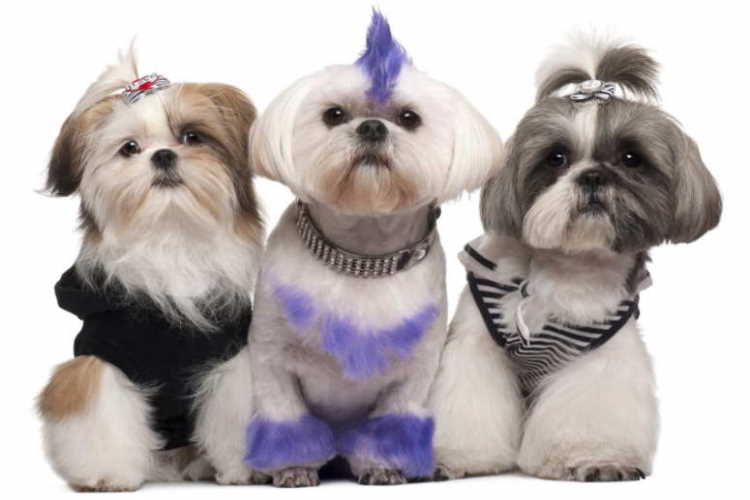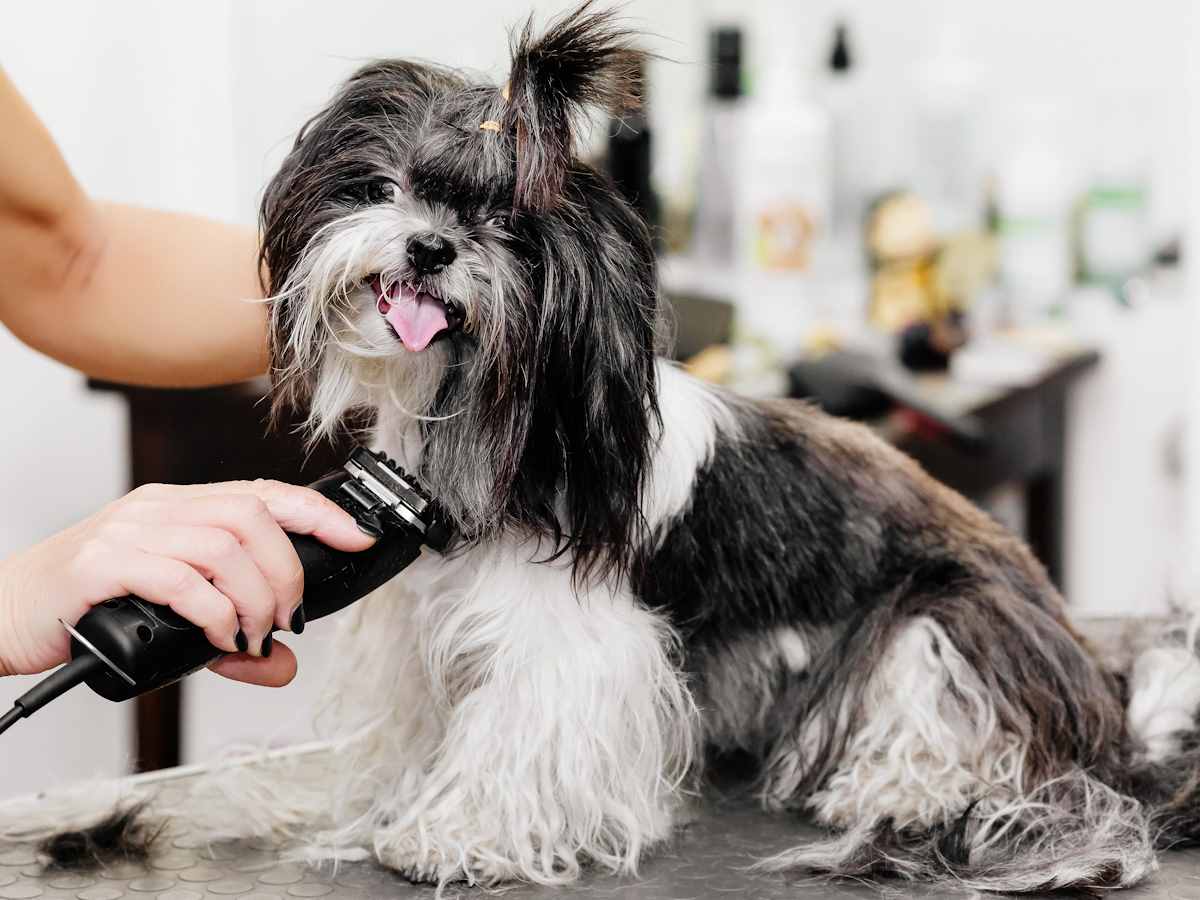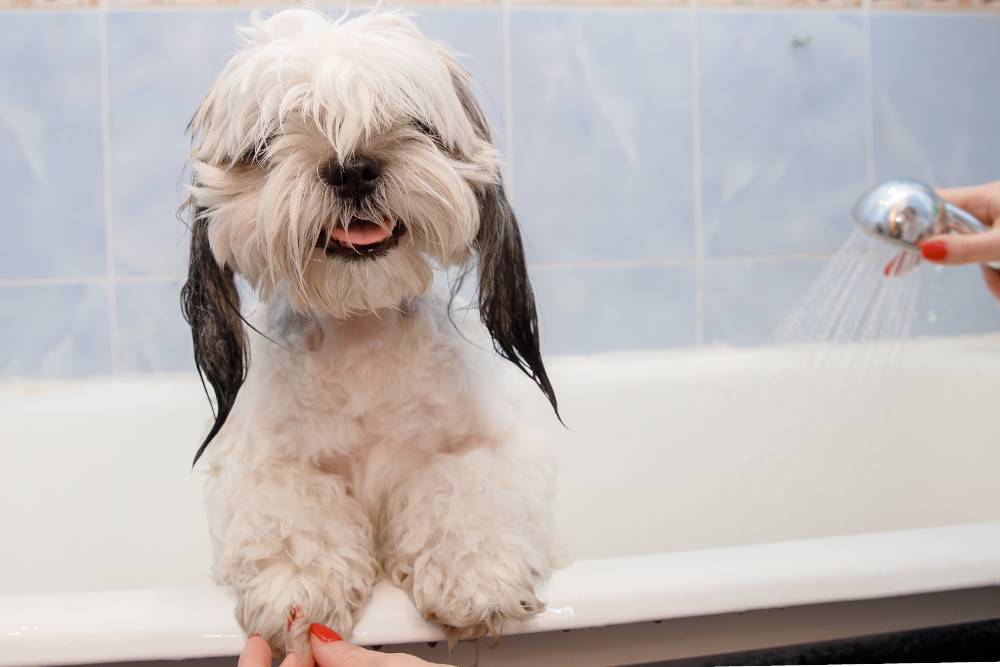Bathing Your Shih Tzu: 8 Simple Tips To Make Bath Time Better
JANUARY 23, 2019 | WRITTEN BY MOLLY
Over the years I've learned a few tricks that have helped make my Shih Tzu dogs bath time a lot less stressful for both them and me.
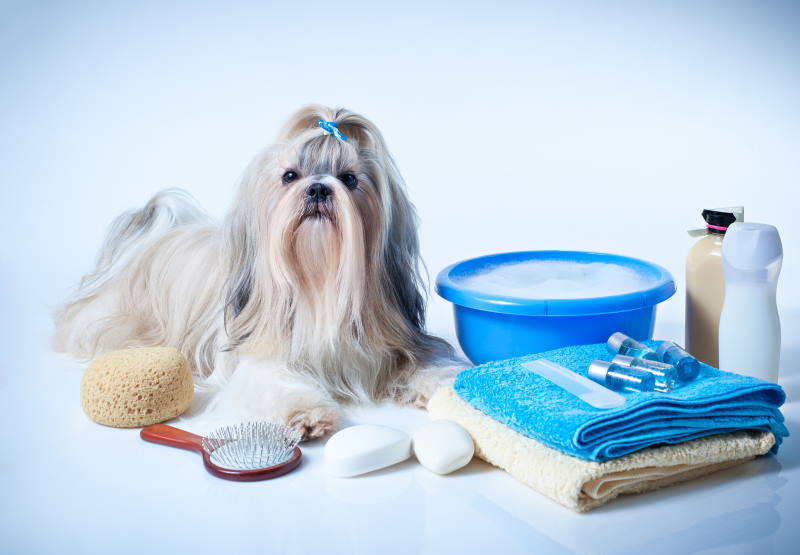
By using these 8 simple tips for bathing your Shih Tzu, it can make the whole experience a lot less of a chore and more of a bonding moment for both of you!
- Brush your dog's hair before his bath
- Give your dog a grip in the tub or sink
- Use a tub restraint for safety
- Choose dog-friendly shampoo
- Use dog-friendly water temperature
- Start bathing your Shih Tzu at their feet
- Use a towel to dry your dog
- Reward your dog's time for the bath
1. Brushing your dog's hair before his bath
Okay seems pretty basic. Many of you probably already do this, but it is always a good first step before getting your dogs coat soaked.
Many dogs enjoy a good combing of their coats, it's very soothing and relaxing and when done before the bath it may leave them with the impression that a bath isn't all that bad.
Not only does brushing your dog’s coat relax him, but when done before his bath it helps keep his hair from becoming a matted mess from any of those seen or unseen tangles and knots.
Believe me, it’s a
heck a lot easier to brush the tangles and knots out on dry hair than it is
wet.
But not only that, by working out tangles and knots first, it allows shampoo to get through the coat and to the skin more easily.
And brushing helps remove any dirt build-up which also makes it easier to wash your dog, allowing you spend less time hunched over the tub while washing him.
2. Get a Grip
A dog is out of their element when standing in a slick bathtub.
Generally dogs don’t like to be unsteady on their feet, and slipping around in a bathtub will be very uncomfortable for them and they will do their best to get out of that slick environment to find steadier ground.
This is where a good tub grip will help.
Use a rubber or textured grip, (I use the Gorilla Grip Tub Mat ) to help your dog stand safe and secure while getting a bath.
Or you could even use a towel in the bottom of the tub if you do not have a rubber grip. A towel will do just fine if you are in a pinch!
For small dogs and puppies, the bathtub may be too big and they have a tendency roam away from you while your washing them.
So you can opt to bathe them in a sink or even a portable tub instead.
Keep in mind that a sink is typically higher off the ground than a bathtub, and if your pup jumps out, he could be seriously injured.
To avoid this from happening, use a tub restraint.
3. Use a tub restraint for safety
If you have a Shih Tzu who is constantly trying to get out of the tub while you are bathing him (I'm talking about you Rufus!) you know how frustrating and dangerous it can be.
I've found using a restraint like the Pro Guard Dog Grooming Stay-N-Wash Tub Restraint, will help you safely keep your pup in the tub.
This way you can get him clean without worrying about chasing a wet dog down the hall or slipping in the bathroom.
4. Choose dog-friendly shampoo
This may come as a surprise to you, but dogs have sensitive skin.
I would have thought with them being related to wolves and the wilderness, they would have tough skin.
But, it turns out that human shampoo and soap can irritate a dog’s skin and cause itchiness and dryness.
Using dog-friendly shampoos, like Earthbath Oatmeal & Aloe Shampoo helps promote a healthy coat and restore your dog’s naturally occurring oils.
Plus, these shampoos feel more gentle on your dog’s eyes, though you should try to avoid getting it in their eyes in the first place.
5. Use dog-friendly water temperature
As mentioned in the section about dog-friendly shampoo, your dog’s skin is sensitive.
Some of us like scalding hot showers, but this will not do for your dog.
It is safer to use lukewarm water with your dog. This is more comfortable than cold water but is not harmful either.
If your dog has a skin condition, there may be an exception to this rule.
Talk to your dog’s veterinarian for recommended a water temperature if your dog has irritated or hypersensitive skin.
6. Start bathing your dog at the feet
Starting your dog’s bath by washing his head first can make for an unpleasant experience for him.
If soap gets in his eyes and you still have the rest of the body to go, then he suffers while you finish the bath.
This results in your dog being afraid of getting bathed when the time next comes around.
Also, your dog’s body temperature will thank you if you start at the feet.
Since your dog is not submerged but is standing in the water, he will feel better if he is not standing while dripping and getting cold.
After you lather up his body from the feet up, you rinse in the opposite direction: from head to feet.
This helps close the process quickly and minimizes the time that shampoo is near your dog’s eyes.
7. Dry your dog with a towel
Drying your dog with a towel is not the simplest task, and you may get a little wet in the process, but this is the most effective method.
Don’t give into the temptation to let your dog outside to air dry.
Dogs are not familiar with a clean shampoo scent, so if you let a freshly bathed and wet dog outside to air dry, he’s going to roll in mud and dirt to absorb new smells.
And ruin all your hard work.
Some sources recommend using a hair dryer to dry your dog. This may be okay but consider your dog’s personality before doing this.
Some dogs are afraid of loud noises or may think the hair dryer is a threat in some way and try to fight it.
This may be adorable at first, but you'll soon find that it makes it difficult to dry them and frustration will undoubtedly set in.
However, if you are successful in getting your Shih Tzu to trust the hair dryer, be sure to use a cooler setting and move it around frequently so there will be less chance of burning them.
8. Reward your dog's time for the bath
I know, you may be thinking that you’re the one who needs a reward after bathing your dog.
But your dog will cooperate with the process better if it is a rewarding experience. Just like brushing him before will be a pre-bath reward, a good treat after the bath will work wonders.
Rewarding a dog for certain tasks reinforces good behavior.
If you want your Shih Tzu to cooperate better with bath time, then try using special treats you only give him before or after the bath.
You can also reward this time with a special toy or bone, or a simple verbal reward and ear rub (this is my Rufus' preferred method of reward, while Max would rather have the treat)
Keep this reward specific to bath time and do not use it in other situations.
This helps ensure your dog will associate the treat or toy with only the bath, which helps them get in the tub without fighting you about it.
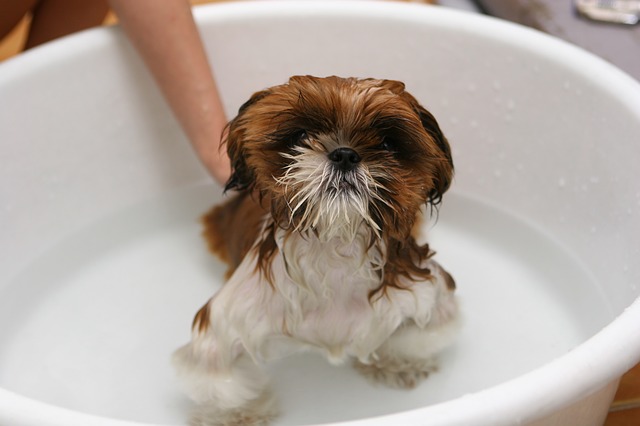 Bathing a Shih Tzu
Bathing a Shih TzuAlso, if your dog runs when you start the water or say “bath” then do not chase him.
Chasing him encourages him to run more.
It may start to become a game to him, which rewards the negative behavior of running instead of encouraging the good behavior of getting in the tub!
How Often Should You Bathe a Shih Tzu
People have conflicting opinions on the how often you should bathe your Shih Tzu.
Some say bathing too often inhibits the production of your dog’s natural oils and recommend every 3 weeks. Others say a weekly bath is fine.
If you are unsure about how often to bathe your dog, a quick chat with your dog’s veterinarian may help.
Long haired "show dogs" like the Shih Tzu are typically bathed daily.
But if you are not concerned with having your dog win first prize sitting around the house, you don't have to bathe him as often.
However, a daily brushing to remove dirt and keep his hair from matting would be beneficial to your Shih Tzu.
You can better make an informed decision about how often to bathe your dog by considering the length of the coat, and the frequency of time he spends time outside.
A short-haired, indoor dog may not need as frequent baths as a long-haired, outdoor dog!
But, in any case, don’t hesitate if your dog smells funny or got himself into a mess. When this happens, giving your dog a bath can help him feel better.
And your nose will appreciate a clean pup too!
